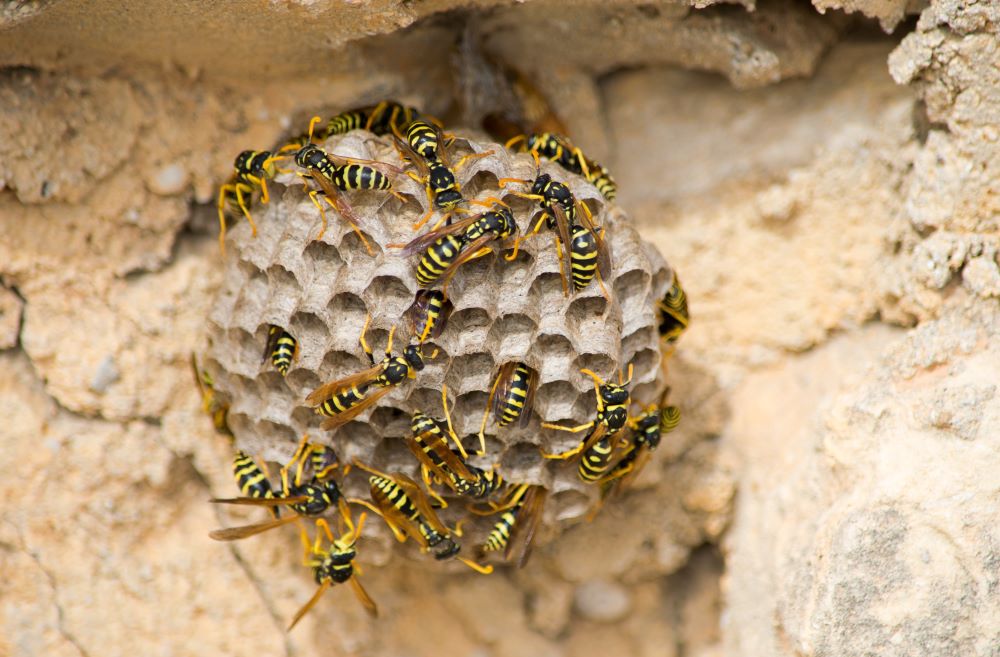Paper wasps, scientifically known as Polistes spp., are fascinating creatures that inhabit various regions around the world, including the arid landscapes of Arizona. These wasps are well-known for their distinctive appearance and intricate nest-building abilities. In this article, we will delve into the life and behavior of paper wasps in Arizona, shedding light on their characteristics, life cycle, behavior, feeding habits, interaction with other insects and animals, as well as safety precautions and conservation efforts.
Characteristics Of Paper Wasps
Paper wasps are easily recognizable by their slender bodies, elongated wings, and vibrant colors. They typically measure between 1 to 2 inches in length and boast a narrow waist, giving them an elegant yet intimidating appearance. The most common species found in Arizona is the Polistes comanchus, which exhibits a combination of black and yellow coloration. Unlike other wasp species, paper wasps have long legs that hang down during flight, making them distinguishable even from a distance.
Life Cycle Of Paper Wasps
The life cycle of paper wasps begins in the spring when the queen emerges from hibernation and starts constructing her nest. She chews plant fibers and mixes them with saliva to form a paper-like substance, which she uses to build a small, umbrella-shaped nest. Once the nest is complete, the queen lays eggs within individual cells. These eggs hatch into larvae, which the queen diligently feeds until they reach the pupal stage. After a few weeks, adult wasps emerge, marking the end of the life cycle. It is important to note that the queen is the sole reproducer, while the other wasps serve as workers, aiding in nest construction and foraging for food.
Behavior Of Paper Wasps In Arizona
Paper wasps in Arizona exhibit fascinating behaviors that contribute to their survival and social structure. They are highly social insects and live in colonies consisting of a queen and her workers. Unlike other wasp species, paper wasps are relatively docile and will not sting unless they feel threatened. These wasps are diurnal, meaning they are active during the day and rest at night. They are known for their exceptional navigation skills, which allow them to locate food sources efficiently. Paper wasps are also highly territorial and will defend their nests vigorously if they perceive a threat.
Paper Wasp Nests And Colonies
Paper wasp nests are a marvel of engineering, showcasing the wasps’ remarkable construction abilities. The nests are typically built in sheltered locations, such as under eaves, in tree branches, or in attics. Constructed from the chewed plant fibers, the nests consist of multiple hexagonal cells, each housing a developing wasp. The nests grow in size as the colony expands, and can house several hundred wasps. As the summer ends, the colony begins to decline, and the new queens hibernate during the winter, establishing new colonies the following spring.
Paper Wasp Diet And Feeding Habits
Paper wasps are omnivorous insects, feeding on a variety of food sources. Their diet primarily consists of nectar and other sugary substances, which they obtain from flowers, fruits, and even honeydew secreted by aphids. However, paper wasps also play an important role in pest control as they are known to prey on other insects, including caterpillars, flies, and spiders. The captured prey is chewed into a pulp and fed to the developing larvae in the nest. This behavior not only ensures the survival of the colony but also helps regulate the population of potential pests.
Interaction With Other Insects And Animals
Paper wasps interact with a diverse range of insects and animals in their environment. They often engage in territorial disputes with other wasp species, such as yellow jackets and hornets. These confrontations may result in aggressive aerial battles, as each species seeks to protect its nest and resources. Additionally, paper wasps serve as a food source for various animals, including birds, spiders, and praying mantises. These natural predators help maintain a balance in the ecosystem by controlling the population of paper wasps.
Paper Wasp Stings And Safety Precautions
While paper wasps are generally non-aggressive, they possess a potent sting that can cause discomfort and allergic reactions in some individuals. It is important to exercise caution when near their nests and avoid sudden movements or loud noises that may provoke them. If stung, it is recommended to clean the affected area with soap and water, apply a cold compress to reduce swelling, and seek medical attention if any severe allergic reactions occur. To prevent paper wasp infestations, it is advisable to seal openings in your home and remove potential food sources, such as fallen fruits or open garbage bins.
Conclusion – Paper Wasps In Arizona
Paper wasps are fascinating insects that contribute to the ecological balance of Arizona’s arid landscapes. Their distinctive characteristics, intricate nest-building abilities, and beneficial behaviors make them an integral part of the ecosystem. By understanding their life cycle, behavior, feeding habits, and interaction with other insects and animals, we can coexist with these creatures harmoniously while taking necessary safety precautions. Remember, if you need assistance in keeping your Arizona home free from wasps, Victory Pest Defense is here to help. Contact us today for a free quote!
